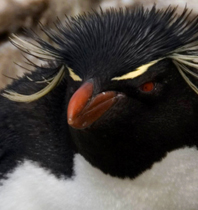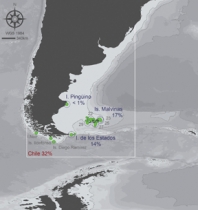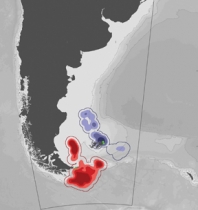|
 |
 | Southern Rockhopper Penguin (Eudyptes chrysocome).  |
 |
Regional Nesting Sites of the Southern Rockhopper Penguin (Eudyptes chrysocome).
References. Green dots: colonies and the percentage of the world population that each area represents. Blue text: populations for which the Atlas provides distribution data. Red text: populations for which there are no data. Blue circle: colonies of origin of individuals studied.
| © Klemens Pütz |
 |
Nesting Sites |
 Spring (Malvinas and Staten Is.) Spring (Malvinas and Staten Is.) |
During incubation, the adults of Southern Rockhopper Penguin are generally able to move further away from the colony in search of food than during the chick-rearing period. The penguins on the Malvinas Islands mainly feed in waters of the continental shelf whereas those on Staten Island make greater use of ocean and slope waters.
Data on adults of both sexes from Malvinas Islands (20 individuals from 2 colonies, 10 studied with GLS) and Staten Island (7 individuals, GLS). Period: October-December.
Dataholders: K. Pütz (Malvinas Islands); K. Pütz, A. Schiavini and A. Raya Rey (Staten Island).
 |  Summer (Malvinas and Patagonia) Summer (Malvinas and Patagonia) |
Summer is the season for chick-rearing and the Southern Rockhopper penguins feed in waters close to their colonies. No overlap in the feeding areas used by individuals on the Malvinas Islands and Staten Island has been observed.
Data on adults of both sexes from Malvinas Islands (26 individuals, 3 colonies), Staten Island (24 individuals) and Pingüino Island (1 individual). Period: January-March.
Dataholders: K. Pütz (Malvinas Islands); K. Pütz, A. Schiavini and A. Raya Rey (Staten Island); K. Pütz, E. Frere and P. Gandini (Pingüino Island).
 Autumn (Malvinas and Patagonia) Autumn (Malvinas and Patagonia) |
Southern Rockhopper penguins migrate for post-reproductive feeding. Adults from the Malvinas Islands principally migrate northwards and westwards, feeding in shelf and slope waters, and in coastal waters close to Puerto Deseado. Penguins from Staten Island feed in coastal waters to the north of Tierra del Fuego, and within the Antarctic Polar Front zone.
Data on adults of both sexes from Malvinas Islands (35 individuals, 4 colonies), Staten Island (23 individuals) and Pingüino Island (1 individual). Period: April-June.
Dataholders: K. Pütz (Malvinas Islands); K. Pütz, A. Schiavini and A. Raya Rey (Staten Island); K. Pütz, E. Frere and P. Gandini (Pingüino Island).
 |  Winter (Malvinas and Staten Is.) Winter (Malvinas and Staten Is.) |
Southern Rockhopper penguins feed mainly to the north of the sub-Antarctic Front, on Burdwood Bank, the continental shelf that surrounds Tierra del Fuego and to the north of the Malvinas Islands.
Data on adults of both sexes from Malvinas Islands (6 individuals, 2 colonies) and Staten Island (3 individuals). Period: July-September.
Dataholders: K. Pütz (Malvinas Islands); K. Pütz, A. Schiavini and A. Raya Rey (Staten Island).
|
 |
Southern Rockhopper Penguin
Eudyptes chrysocome
Regional Nesting Sites: The species was recently split into 2: the Southern Rockhopper Penguin (E. chrysocome) and the Northern Rockhopper Penguin (E. moseleyi). The northern species breeds on the sub-Antarctic islands of the Tristan da Cunha group (Atlantic Ocean) and at Amsterdam and St. Paul islands (Indian Ocean). The Southern Rockhopper Penguin breeds on the Malvinas Islands, Staten Island and on islands of southern Chile (Ildelfonso, Diego Ramírez, and others) as well as at sub-Antarctic islands in the Indian Ocean and in the Australasian region. Diet: They feed mainly on crustaceans, fish and squid, which they catch on dives that do not exceed 30 m. World breeding population: Estimated at 1.2 million pairs. Conservation Status: Vulnerable (IUCN, 2008). Over the last 70 years the population on the Malvinas Islands has decreased by nearly 90%. Main threats: Increasing disturbance from ecotourism, fisheries, and hydrocarbon exploitation and pollution.

|

